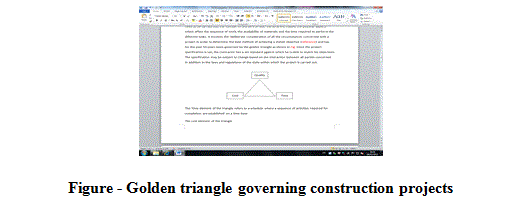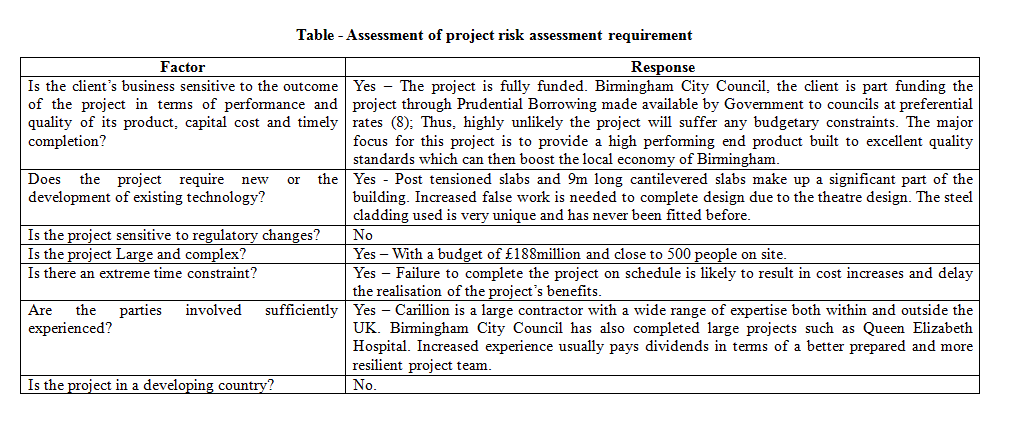The Library of Birmingham Project Time Risk Assessment
(extract)
ABSTRACT
All projects, by their very nature, are subject to risk. The objective of the risk analysis and management process is to minimise the impact of negative events on the project plan whilst allowing the team to take maximum advantage of any opportunities which present themselves.
The following report is a robust first stage to managing the construction time risks associated with the Library of Birmingham. Intolerable risks associated with mobile plant, fire, ground works and excavations, etc. have had contingencies put in place to help the project team deal with them in the event of occurrence. Tolerable risks for the project including a shortfall in supply of labour, equipment and material due to the 2012 London Olympics, archaeological finds and a range of health and safety risks remain within the project. The contractor, Carillion, now has a clear perception of the construction risks being borne, ensuring that sufficient capability, competence and experience to deal with any such risks are in place through effective project management.
If the Library of Birmingham is to succeed the risks identified must be tracked and managed effectively. Risk management will be an on-going process for the life of the project. Some risks will mature or be successfully mitigated, new risks will be identified, tracked and managed right up until the project is successfully completed and opened, come September 2013.
- INTRODUCTION
The project considered is the Library of Birmingham, a £188million building project. This seeks to replace Birmingham’s Central Library, the largest and busiest public library in Europe, with a new state-of-the-art facility fit for the 21st century with over 3 million visitors expected each year (1). Images of the exterior and interior of the library when completed are shown in Fig. 1 (2).

1.1 Construction risk management
Construction projects by their nature are faced with unexpected events as each project is unique. Construction risk management then aims to make effective decisions about what happens in the future, supported through effective analysis. Building on the lessons of past projects, it aims to focus on creating a better future where effective change can be implemented through combining past experience with new and innovative techniques. Construction risk management enables the project team to recognise potential sources of risk for a particular project which are likely to have a high impact on the project and their probability of occurrence. Post this assessment, the project team is able to adopt mitigation measures and better manage the residual risks while exploiting opportunities which present themselves (3-5).
1.2 Aim
The aim of this report is to complete a time risk assessment for The Library of Birmingham.
1.3 Objectives
Key objectives to aid in completing this assessment include: (i) Describe the importance of project risk management for the selected project. (ii) Collect risk information and data for the project. (iii) Identify time hazards for key activities within the project by an appropriate technology. (iv) Analyse risks of a project and pay attention to an appropriate technology. (v) Analyse outputs and give suggestions of risk reduction.
1.4 Report structure
Section two highlights the risk management requirements of the Library of Birmingham.
Section three considers risk information and data collection necessary.
Section four considers the hazards identified for this project.
Section five analyses all the risk data collected.
Section six provides an output and discusses all the data collected.
Section seven provides a series of recommendations as to how to effectively deal with the risks associated with the project
Section eight discusses future work to be following on from this study
Section nine concludes the study highlighting key points.
Section ten offers references the various sources which have backed the study.
- RISK MANAGEMENT REQUIREMENTS
For any given construction project, the risk management requirements are governed by the golden triangle as shown in Fig. 2(6).

The time aspect details factors which will affect the length of the project. The cost aspect details factors which affect the final price. The quality aspect details the performance to the final project, matched up against that which is specified. It is important to consider the impact a variation of one factor has on the others. The following study will be based on the time risks (6,7). The construction project risk management requirement is based upon a series of factors summed up in Table 1 (1,2). In summary, the Library of Birmingham is not a small, repetitive, straightforward, fully controllable project. In addition, due to the high level of innovation, the busy site location and the variety of different works which will be required, a risk assessment is necessary.

- REFERENCES
(1) Birmingham CC. The Library of Birmingham. 2012; Available at: http://www.birmingham.gov.uk/cs/Satellite/library-of-birmingham?packedargs=website%3D4&rendermode=live. Accessed April 30, 2012.
(2) Carillion. Library of Birmingham. 2012; Available at: http://www.carillionplc.com/our-markets/local-authorities.aspx#casestudy. Accessed April/30, 2012.
(3) An M. Construction project risk management. 2012.
(4) Smith NJ. Managing risk in construction projects. : Blackwell Science; 1999.
(5) Barry Fryer MF. The Practice of Construction Management. 3, illustrated ed.: Blackwell Science; 1997.
(6) Winch G. Managing construction projects. : Blackwell publishing; 2002.
(7) Dale F. Cooper, C. B. Chapman. Risk analysis for large projects: models, methods, and cases. illustrated, reprint ed.: Wiley; 1987.
(8) Birmingham CC. Conceptual Design, Library of Birmingham. 2012; Available at: http://birminghamnewsroom.com/2010/01/6349/. Accessed April/ 30, 2012.
(9) HSE. Health and Safety Statistics. 2012; Available at: http://www.hse.gov.uk/statistics/. Accessed April/30, 2012.
(10) HSE. CDM Regulations. 2012; Available at: http://www.hse.gov.uk/construction/cdm.htm. Accessed April/30, 2012.
(11) MET O. Weather information, Birmingham, UK. 2012; Available at: http://www.metoffice.gov.uk/climate/uk/interesting/2012_janwind/. Accessed April/30, 2012.
(12) HSE. Risks contributing to accidents on site. 2011; Available at: http://www.hse.gov.uk/statistics/causinj/index.htm. Accessed April/30, 2012.
(13) David J. Smith. Reliability, Maintainability and Risk: Practical Methods for Engineers. 8, illustrated ed.: Elsevier; 2011.
(14) F D, C C, Chapman CB. Risk analysis for large projects: models, methods, and cases. . illustrated, reprint ed.: Wiley; 1987.
(15) Signs S. Emergency exit signs. 2012; Available at: http://blog.stocksigns.co.uk/safety-signs-audit/. Accessed April/30, 2012.
(16) Martin Loosemore, Andrew Dainty, Helen Lingard. Human Resource Management in Construction Projects: Strategic and Operational Approaches. illustrated ed.: Taylor & Francis; 2003.